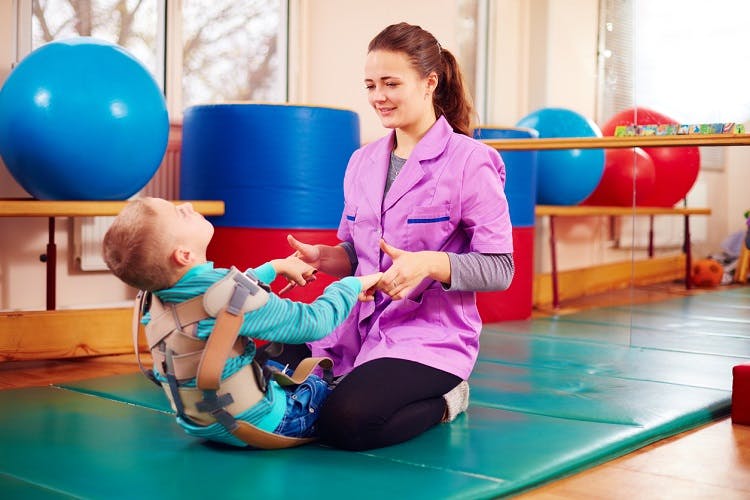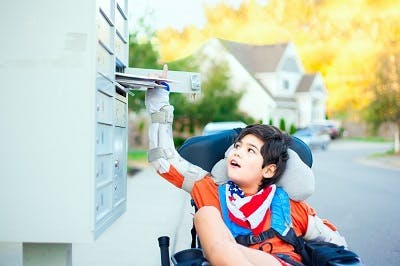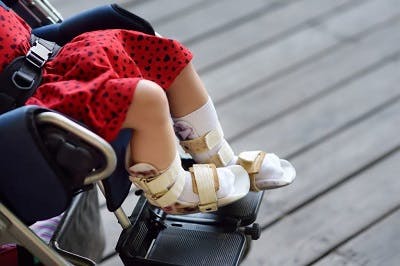No products in the cart.
No products in the cart.
No products in the cart.
No products in the cart.
Home » Neurological Recovery Blog » Cerebral Palsy » Orthotics for Cerebral Palsy: Goals, Benefits, and Long-Term Outcomes
Last updated on June 18, 2021

Orthotics are wearable medical devices that play an important role in the management of cerebral palsy. Because cerebral palsy generally affects movement starting from a very young age, early use of orthotics can significantly minimize the progression of complications and optimize functional independence.
To help you better understand the use of orthotics in the management of cerebral palsy, this article will discuss:
The primary goal of orthotics in the management of cerebral palsy is to provide structural support.
This is important because cerebral palsy is a developmental motor disorder, which means it can affect an individual’s movements, balance, coordination, muscle tone, and posture.
Because it is caused by damage to the brain before, during, or shortly after birth, the effects of cerebral palsy often affect individuals starting at a very young age. However, those with milder forms of CP may not notice motor impairments until they get older.
The earlier cerebral palsy is identified, the sooner individuals can seek management for it. Early intervention can help significantly reduce the progression of motor impairments and minimize the severity of secondary complications like pain, deformity, and spasticity.
In the following section, we’ll discuss the various benefits of wearing orthotics for managing cerebral palsy.

Depending on the severity of one’s cerebral palsy and how it affects their functional abilities, a physical therapist, occupational therapist, or physician may recommend different types of orthotic devices such as splints, braces, or casts.
Orthotic devices can be pre-fabricated or custom-made, depending on the needs of the wearer. While “off-the-shelf” style orthotics can be appropriate for cerebral palsy management, individuals with more specialized needs may have a therapist or orthotist recommend a personally designed and created orthotic. Either way, it is best to have a professional review orthotic donning (putting on) and doffing (taking off) techniques, proper fit, wearing schedule, and care with you.
The earlier orthotic treatment begins, the easier it is to manage cerebral palsy and its complications.
Below, we’ll discuss how orthotic devices can help individuals with cerebral palsy become as functional as possible:
One of the most prevalent secondary effects of cerebral palsy is spasticity. Spasticity refers to high muscle tone caused by involuntary muscle contractions. It can place excess pressure on the muscles and joints, causing stiff movements, sudden jerking, joint dislocation, and pain.
Wearing an orthotic device on the affected area(s) of the body can help significantly reduce the impact of spasticity. Orthotics help hold the body part in place to prevent unwanted movements and minimize spastic muscles from further tightening.
Additionally, orthotics will help gently stretch tight muscles, even when the individual is not actively moving. This allows for passive lengthening of spastic muscles, which also helps minimize the progression of spasticity.
Individuals with cerebral palsy can experience high or low muscle tone, or a combination of both. When someone has low muscle tone in their abdominal muscles, they often have poor trunk stability and balance skills, which compromise posture. Likewise, high muscle tone can pull the body into abnormal postures.
To help combat these complications, a physical therapist or physician may recommend wearing a trunk brace. It should provide the stability and structural support necessary to help individuals sit upright.
Spasticity strains the musculoskeletal system, which may contribute to the development of chronic pain. Consistent musculoskeletal pain can disrupt sleep, affect mood, and hinder growth in children with cerebral palsy.
Orthotics help correct musculoskeletal alignment to relieve pain caused by excess pressure on the muscles, bones, and joints.
Because cerebral palsy-related motor impairments generally present themselves in early childhood, they can significantly interfere with an individual’s growth and development.
Children are constantly growing, and high muscle tone can pull the body into abnormal positions. When the muscles remain contracted for prolonged periods while children are growing, deformities may develop. Orthotics help correct these abnormal positions before they become problematic.
While not all orthotics are custom-made, those prescribed by a medical professional usually are. Every body is different, so ensuring that your child’s orthotics are a good fit helps ensure the maximum amount of support and effectiveness.
Because individuals with cerebral palsy struggle with motor control, posture, and balance, their bodies generally have to exert more energy to perform movements.
Orthotics help stabilize and support correct musculoskeletal alignment to promote better form and minimize excess strain on the body. This helps conserve energy and discourages irregular movement patterns.
Another major benefit of using orthotics in the management of cerebral palsy is that they are generally very low risk. Orthotics are wearables, which means if they cause the wearer distress, they can be taken off at any time.
Additionally, orthotics are an excellent, non-invasive, and relatively affordable way to delay or avoid the need for surgery.
Now that you understand how orthotics can be beneficial for individuals with cerebral palsy, let’s discuss how long orthotics should be worn.

How long your child will need to use orthotics depends on the severity of their cerebral palsy. Because every case of cerebral palsy is unique, a personalized approach to rehabilitation is ideal.
Some individuals may only need to wear their orthotics for a few minutes a day while others may need to wear them throughout the day or during sleep. Speak to your child’s doctor or therapist to determine the recommended amount of time they should be wearing their orthosis each day.
It’s also important to avoid becoming overly dependent on orthotics and understand how to wean your child off them. If your child relies too heavily on orthotics, they will not learn how to engage their muscles without them.
Neuroplasticity is the brain’s ability to rewire itself, which allows for functions affected by brain damage to be reorganized to healthy areas of the brain. By utilizing neuroplasticity, individuals with cerebral palsy can train their brains to make adaptive changes and improve their motor functions.
The most effective way to promote neuroplasticity is to repetitively practice the functions you want to improve. This stimulates the brain and reinforces demand for those functions.
Orthotics help correct form and combat spasticity to promote more natural movements. Once your child gets accustomed to practicing the corrected movement pattern, speak with their therapist or doctor about whether it’s appropriate to start gradually reducing the amount of time the orthotic device is worn and begin training without it.
The more your child practices a specific movement, the stronger the new neural connections for it become until eventually, your child may no longer require orthotics.
Many individuals with cerebral palsy use orthotics to manage their motor impairments.
However, orthotics should be used as a temporary aid. Once your child starts demonstrating more natural movement patterns, try weaning them off orthotics to encourage active muscle engagement.
It isn’t easy, but with consistent practice, your child can train his/her brain to rewire itself and improve motor functions.
We hope this article helped you understand the benefits of orthotics for CP management and how to utilize them to optimize long-term outcomes.

Get our free 19-page PDF full of helpful tips for cerebral palsy by signing up below! If you liked this article, you’ll LOVE our free ebook.
When you sign up, you’ll also receive our popular emails that share more tips for life with cerebral palsy — you can opt out anytime.
We will never sell your email address, and we never spam. That we promise.


At Flint Rehab, we understand that doing physical therapy at home can become tedious and repetitive. But when repetition is critical to recovery, it’s important to stick with a repetitive regimen. But that doesn’t mean it has to be boring.
Flint Rehab is the leading manufacturer of motion-sensing, gamified rehabilitation devices. Our bestselling recovery tool, FitMi, transforms full-body rehab exercises into an interactive experience.
See what individuals with CP are saying about FitMi:
“The FitMi and MusicGlove have done wonders for my son with hemiparesis from cerebral palsy and stroke. It motivates him to do his exercises. It does not seem like therapy for him since it is fun. FitMi monitors his progress so it is a great reinforcement for him. Music is a motivator for him. He has been using it on his arm and we will try the leg exercises soon.”
-Manning
While FitMi is a recovery tool for the full-body, our other device, MusicGlove, helps target the hand to improve fine motor skills and dexterity.
See what others have said about MusicGlove:
“My granddaughter has right-side hemiplegia from Cerebral Palsy / stroke at birth. She states that this is a great product for anyone who has issues with the use of their hand(s), and that is has helped her tremendously. She also finds the music quite catchy (surprisingly!). Our occupational therapist has been impressed as well. I can say that it has arguably been the best tool of all our therapy resources.”
-Jenni
Together, FitMi and MusicGlove make a powerful home therapy regimen for individuals with cerebral palsy. Best of all, you can save money when you bundle them together.
To learn more, click the button below:

Do you have these 19 pages of helpful tips for CP?
Get a free copy of our ebook Helpful Tips for Managing Cerebral Palsy. Click here to get instant access.
Grab a free rehab exercise ebook!
Sign up to receive a free PDF ebook with recovery exercises for stroke, traumatic brain injury, or spinal cord injury below: